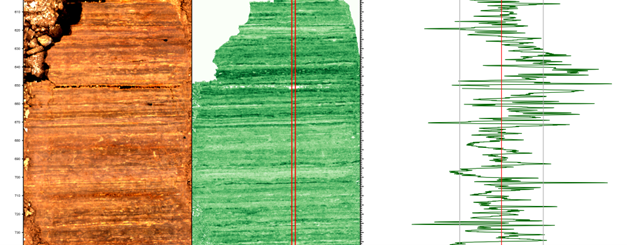Biomarker
- ELSA GDGT Data
Several cooperations partners tested the applicability of the maar sediments for biomarker studies. These results are published (Kappenberg et al., 2020, Hepp et al., 2019, 2016; Bandowe et al., 2014; Anhäuser et al., 2014). High resolution measurements have been undertaken for GDGT paleotemperature, results have been published by Zander et al. (2023). Bile acids, stanols and sterils are published by Birk et al. (2021).
Through collaboration with Uni Mainz and the Max Planck Institute for Chemistry (Mainz), biomarkers for paleoclimate reconstruction have been analyzed from ELSA stack samples. n-alkanes are organic compounds derived from plant waxes that are well preserved in the maar lake sediments. The proportion of various alkane chain lengths provides information about changing vegetation around the lake as well as the proportion of organic material that is derived from aquatic production or terrestrial vegetation. n-alkane measurements on ELSA stack samples from the past 60,000 years have shown good agreement with pollen reconstructions of vegetation and indicate that warm intervals (MIS 3 and interstadials) featured more trees, while cold intervals were dominated by grasses and much lower aquatic productivity (Sirocko et al., 2022). Ongoing research is focused on measuring the C and H stable isotopes of the n-alkanes in ELSA samples to reconstruct hydroclimate changes during millennial-scale rapid warming events.

A second class of organic compounds, glycerol dialkyl glycerol tetraethers (GDGTs), has been analyzed in the same ELSA-stack samples. These compounds are membrane-spanning lipids of archaea and bacteria. Research has shown that these compounds originate primarily from organisms living within the lake, though some input from the surrounding catchment is possible, especially during the cold glacial period. A recent publication on ELSA GDGTs (Zander et al., 2024) showed that these compounds can be used to successful estimate warm-season temperatures in the past. An important finding was that anoxic conditions in the maar lakes has an influence on the reconstructed temperature using this proxy, but a special GDGT compound that is only produced under anoxic conditions can be used to diagnose and correct this bias. The results show warm-season temperatures at about 12°C during the Holocene, 10°C during GI16-14, and about 8°C during the younger interstadials. Stadial temperatures were similar as during the LGM.
Hyperspectral Imaging Core Scanning
Through collaboration with the University of Bern, hyperspectral images have been taken of ELSA cores (Auel Maar and Hoher List). This recently developed method makes it possible to obtain geochemical data from sediment cores at unprecedented resolution (data points every <0.1 mm). Thus far, the focus has been on estimate the abundance of pigments in the sediment, particularly total chlorophyll, which is a proxy for total aquatic productivity. A calibration has been established to calculate chlorophyll concentrations from hyperspectral imaging index data. The resulting sub-annual resolution time series has been compared to the NGRIP ice core δ18O record, and shows that decadal to multidecadal climate fluctuations were likely synchronous between Greenland and the Eifel. This is particularly observed during the interstadial phases of the glacial period (Albert et al.subm. Quaternary).

Biomarker-related Papers:
Albert, J., Zander, P. D., Grosjean, M., and Sirocko, F. Fine-tuning of sub-annual resolution spectral index time series from Eifel maar sediments, Western Germany, to the NGRIP δ18O chronology, 26–60 ka. Quaternary, In review
Zander, P. D., Böhl, D., Sirocko, F., Auderset, A., Haug, G. H., Martínez-García, A. (2024). Reconstruction of warm-season temperatures in central Europe during the past 60 000 years from lacustrine branched glycerol dialkyl glycerol tetraethers (brGDGTs). Climate of the Past, 20(4), 841-864. doi: 10.5194/cp-20-841-2024
Sirocko, F., Albert, J., Britzius, S., Dreher, F., Martínez-García, A., Dosseto, A., Burger, J., Terberger, T., Haug, G. (2022). Thresholds for the presence of glacial megafauna in central Europe during the last 60,000 years. Scientific Reports, 12(1): 20055. doi: 10.1038/s41598-022-22464-x
Birk, J. J., Reetz, K., Sirocko, F., Wright, D., Fiedler, S. (2021). Faecal biomarkers as tools to reconstruct land‐use history in maar sediments in the Westeifel Volcanic Field, Germany. Boreas, Vol. 51, pp. 637–650. doi: 10.1111/bor.12576.
